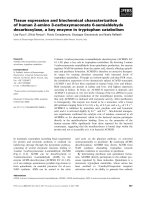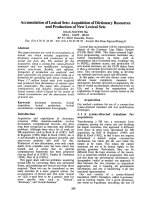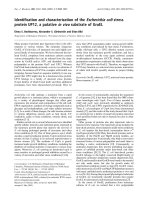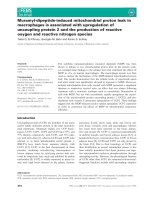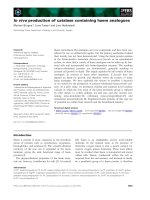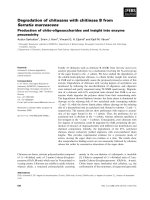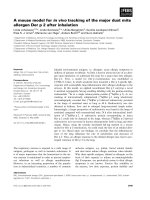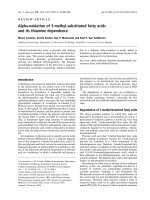Assessing meat production of 3 Hungarian Landrace Guinea Fowl ecotypes reserved for in vivo conservation
Bạn đang xem bản rút gọn của tài liệu. Xem và tải ngay bản đầy đủ của tài liệu tại đây (464.29 KB, 6 trang )
C
2015 Poultry Science Association Inc.
Assessing meat production of 3 Hungarian
Landrace Guinea Fowl ecotypes reserved for in vivo
conservation
I. T. Szalay,∗† T. N. Lan Phuong,∗†,1 T. R. Ferencz,‡† K. D. T. Dong Xuan,∗†
K. Kustos,§ and K. Kovacsne Gaal‡†
∗
Primary audience: Poultry Experts, Researchers, Conservationists
SUMMARY
Guinea fowl (Numida meleagris) has existed in the Carpathian Basin for centuries and now is
becoming an important genetic resource for low-input production. This study aimed to compare
production traits, such as livability, BW, and feed conversion, of 3 Hungarian Landrace Guinea
Fowl (HLGF) ecotypes, 2 from Hungarian gene banks (Godollo (G) and Hortobagy (H)) and
one local type from Central Hungary (C). Beyond 5 wk of age, birds were kept in enclosures
of either 15 m2 or 50 m2 free-range area per bird. The highest average BW and lowest feed
conversion at 14 wk of age (1329.38 ± 101.47 g and 2.916 ± 0.253 kg feed/kg BW gain,
respectively) were recorded for the G ecotype of HLGF, which was kept in 50 m2 free-range
area/bird. An ANOVA test showed that the ecotype of guinea fowl influenced BW and feed
conversion, and the size of the free-range area was found to be a determining factor for feed
conversion rate at 14 wk of age (P < 0.001). Our study results indicate that use of the G ecotype
of HLGF is preferred for meat production and that the size of the free-range area is essential
for keeping any types of HLGF after 5 wk of age. Different HLGF ecotypes also were shown
to exist in rural Hungary, which should be of interest to future conservation programs.
Key words: conservation, free range, local guinea fowl, production
2015 J. Appl. Poult. Res. 0:1–6
/>
DESCRIPTION OF THE PROBLEM
Landrace varieties of guinea fowl originated
from the African helmeted guinea fowl (Numida meleagris) [1,2] and have existed in Europe
since the Roman era. Rodiczky [3] and Krenedits [4] reported that guinea fowls were kept in the
Carpathian Basin as pets around manor houses
1
Corresponding author:
and monasteries in the Middle Ages, although
production of the local variety did not begin until the 20th century. In fact, no breeding programs were elaborated for this type of poultry,
despite its excellent meat and egg quality, good
adaptability to different environmental and keeping conditions, possible resistance to certain diseases, seeking habit, and low cost of keeping, all
of which make the guinea fowl one of the best
choices for premium quality natural production
Downloaded from by guest on January 19, 2016
Research Center for Farm Animal Gene Conservation (HaGK): Isaszegi ut 200, 2100
Godollo, Hungary; † University of West-Hungary, Faculty of Agricultural and Food Sciences
(NYME-MEK): 9200, Mosonmagyar´ov´ar V´ar 2, Hungary; ‡ Szent Istvan University (SZIE):
Pater Karoly utca 1, 2100 Godollo, Hungary; and § Association of Hungarian Small Animal
Breeders for Gene Conservation (MGE): Isaszegi ut 208, 2100 Godollo, Hungary
JAPR: Research Report
2
MATERIALS AND METHODS
Experimental Arrangements
The study was conducted at the poultry farm
of HaGK where one-day-old HLGF chicks were
hatched. The study flocks of the 3 ecotypes consisted of 368 birds from the Godollo gene bank
(G), 169 birds from the Hortobagy gene bank
(H), and 158 birds of a local ecotype from C,
eggs of which were collected directly from landrace flocks in a remote farm region. Although
sexing methods exist for guinea fowl [16], this
species does not exhibit sexual dimorphism in
growth characteristics [17]. Therefore, males
and females were pooled together for investigation. During the first 5 wk, birds were kept in
a closed animal house. From the age of 6 wk,
for any ecotype, 140 birds were distributed between 4 pens (35 birds/ecotype/pen) to study the
effect of free-range keeping on BW and feed
conversion rate. To mimic natural keeping with
random and separated distribution of single ecotype flocks, all ecotypes were provided with a
free-range area of either 15 or 50 m2 /bird. The
free-range area consisted of natural pasture that
was divided by wire fencing into 12 identical
plots (6 plots/row, 35 birds/plot). Each plot was
covered with bird netting and equipped with a
wooden house of 20 m2 in the center. The setup for the experiment is shown in Table 1. The
same feed and water were provided ad libitum
throughout the study. The experimental diet used
is presented in Table 2 [18]. All guinea fowl were
fed the same diet, as recommended by the breeding organization [19]. Survival rate, weekly BW,
and feed consumption were monitored until the
age of 14 wk, which is the earliest slaughter
age of guinea fowl in accordance with organic
and HU-BA (Hungaricum Poultry) rules [19,20].
The study met the guidelines approved by the
Institutional Animal Care and Use Committee
(IACUC).
Statistical Analysis
Data were processed by SPSS 20 [21], using
univariate general linear model to conduct the
Table 1. Arrangement of the experiment.
Wk of age
Label
HLGF∗
1 to 5
G00
H00
C00
G15
H15
C15
G50
H50
C50
Godollo
Hortobagy
Central Hungarian
Godollo
Hortobagy
Central Hungarian
Godollo
Hortobagy
Central Hungarian
6 to 14
∗
Free-range area/bird
Number of pens
Number of birds/pen∗∗
0 m2
0 m2
0 m2
15 m2
15 m2
15 m2
50 m2
50 m2
50 m2
10
4
4
2
2
2
2
2
2
35
35
35
35
35
35
35
35
35
Hungarian Landrace Guinea Fowl.
Number of birds recorded at the beginning of experimental study.
∗∗
Downloaded from by guest on January 19, 2016
[5,6]. Moreover, recent studies have emphasized
that the local landrace guinea fowls, which still
exist in some regions of the Carpathian Basin,
could be a promising genetic resource for the
development of low-input, scavenging keeping
systems [7,8] and could be a reliable contributor
to the livelihood of rural people [9–11].
In 2004, a local Hungarian guinea fowl was
registered under the name of Hungarian Landrace Guinea Fowl (HLGF) by the Association
of Hungarian Small Animal Breeders for Gene
Conservation (MGE). Since then, it has been
kept as part of the in vivo poultry gene bank
by the Research Center for Farm Animal Gene
Conservation (HaGK) and the Hortobagy National Park (HNP) as distinct ecotypes [7]. When
considering how best to conserve any traditional
breed of domestic animal, it is often useful to
determine how it can best be used for production [12–15]. Therefore, the objectives of this
study were to assess BW and feed utilization as
important production traits for the guinea fowl
and to examine the optimal range for traditional,
scavenging keeping systems. To answer these
questions, two HLGF ecotypes were compared
with a local landrace from Central Hungary (C),
whose hatching eggs had been collected before
the study started for conservation purposes.
SZALAY ET AL.: HUNGARIAN GUINEA FOWL ECOTYPES
3
Table 2. Diets used for Hungarian Landrace Guinea Fowl feeding in different periods of
the experiment [18].
Composition
Starter diet
0 to 4 wk of age
Grower diet
5 to 8 wk of age
Finisher diet
9 to 14 wk of age
12.3
23.0
53.5
38.5
12.5
19.0
54.5
12.1
16.0
51.0
29.0
7.0
5.0
20.0
15.0
6.0
4.0
1.0
3.5
1.0
3.0
Metabolisable energy (MJ/kg)
∗
Crude protein (%)
Corn (%)
Soy 48% (%)
Soy 46% (%)
Wheat (%)
Barley (%)
Fin dry fat (%)
∗∗
Favorit 40 (%)
Lime (%)
Premix (%)
∗
4.0
1.0
3.0
analysis of variance for experiments involving 3
factors (ecotype, size of the free-range area, and
pen). Levene’s test was used to assess the equality of variances and was followed by a series of 2way ANOVA tests. The 2-way ANOVA test was
expected to give information about the effects of
the ecotype, size of the free-range area, and pen
factors, as well as their interacting effects on BW
and feed conversion rate. Significant differences
were determined for observed means by post hoc
multiple comparisons (Tukey HSD test), and for
medians by Kruskal-Wallis and Mann-Whitney
tests. The Kruskal-Wallis test was used to identify whether the mean ranks were the same in all
the treatments while the Mann-Whitney test was
used to identify whether the mean ranks are the
same in selected pairs of treatments. Mortality
was compared using the chi-square test.
RESULTS AND DISCUSSION
Survival rate of guinea fowls was generally
high at 90.62% during the first part of the rearing period until the age of 5 wk and 97.06% during the rest of rearing (from 6 to 14 wk of age)
without any differences between the ecotypes
(chi-square test, P > 0.05). Levene’s test showed
that the assumption of homogeneity of variances
was not violated (P > 0.05). As shown by the 2way ANOVA test, the effect of the ecotype was
significant on both BW and feed conversion rate
(P < 0.001 at 14 wk of age), while the effect
of the size of the free-range area was significant
solely on feed conversion rate (P < 0.001 for
feed conversion and P > 0.05 for BW at 14 wk
of age). However, 2-way ANOVA showed there
was no significant effect of the pen and no interacting effects with other study factors on BW
and feed conversion rate (P > 0.05 at 14 wk
of age). Results of BW measurements and feed
conversion rate calculated at both 5 and 14 wk
in the study are shown in Table 3, respectively.
By using a post hoc Tukey HSD test, statistically
significant differences were detected in terms of
BW and feed conversion among the ecotypes
(P < 0.001), except for BW between H and C
ecotypes (P > 0.05) at 5 wk of age; and for feed
conversion between G and H ecotypes (P > 0.05)
at 14 wk of age.
Furthermore, the Kruskal-Wallis test showed
statistically significant differences in BW and
feed conversion between the different treatments
(P < 0.001 at both 5 and 14 wk of age). The average BW of the G ecotype was significantly
greater than that of the other ecotypes at both
ages examined (Table 3). However, feed conversion rate in the G ecotype was found to be
considerably lower than in other ecotypes at 5
wk of age and lower than C15 and C50 but comparable to H15 and H50 groups at 14 wk of age
(Table 3). At the end of the 14-wk rearing period, the lowest average BW and highest feed
conversion rate were recorded in the C50 group,
whereas the highest average BW and the lowest feed conversion were found in the G50, as
shown in Table 3. Figures 1(a) and 1(b) illustrate the comparison of BW and feed conversion rate, respectively, at 14 wk of age of
C, G, and H ecotypes kept in either 15 m2 or
50 m2 free-range area/bird. Marked gaps could
Downloaded from by guest on January 19, 2016
Calculated on dry matter basis.
Fat powder produced by Biofilter Kăornyezetvedelmi Zrt. by recycling food waste.
JAPR: Research Report
4
Table 3. Average BW (g) and feed conversion rate (kg feed/kg BW gain) comparison of Godollo
(G), Hortobagy (H), and Central (C) Hungarian Landrace Guinea Fowl ecotypes kept with 0 m2
(00), 15 m2 (15) and 50 m2 (50) at 5 and 14 wk of age.
Comparisons
5 wk
G00
H00
G00
C00
H00
C00
G15
H15
G15
C15
H15
C15
G50
H50
G50
C50
H50
C50
14 wk
BW
Feed conversion rate
Mean
SD
P value
Mean
SD
P value
315.00
258.24
315.00
237.83
258.24
237.83
1311.18
1219.43
1311.18
1153.53
1219.43
1153.53
1329.38
1254.55
1329.38
1180.00
1254.55
1180.00
75.38
77.43
75.38
66.45
77.43
66.45
80.93
100.06
80.93
105.91
100.06
105.91
101.47
110.26
101.47
105.03
110.26
105.03
<0.001
2.854
4.860
2.854
5.932
4.860
5.932
3.239
3.329
3.239
3.367
3.329
3.367
2.916
2.930
2.916
3.792
2.930
3.792
0.875
1.717
0.875
1.644
1.717
1.644
0.202
0.290
0.202
0.308
0.290
0.308
0.253
0.274
0.253
0.358
0.274
0.358
<0.001
<0.001
0.093
<0.001
<0.001
0.007
0.008
<0.001
0.009
<0.001
<0.001
0.313
<0.001
<0.001
0.844
<0.001
<0.001
P value was calculated by Mann Whitney test; P ≤ 0.05 means medians on a test variable differ significantly
between 2 groups [21].
be observed between feed conversion rates of
G50 and G15, H50 and H15, and C50 and
C15 ecotypes.
Results from this study show that there are
considerable variations in BW and feed conversion rate between 3 HLGF ecotypes, thus providing evidence for differences between conservation stocks (G and H) and local landraces (C).
Therefore, it indicates that the ecotype can be
an important factor in determining guinea fowl
meat production. A larger free-range area, as
demonstrated in this study, seems to improve
considerably feed conversion without any negative effect on BW. This also underlines the importance of free-range keeping of different Hungarian guinea fowl ecotypes from an economic point
of view. In addition, this is in accordance with
the obligatory free-range keeping system for in
vivo gene bank stocks of old poultry breeds in
Hungary [14].
CONCLUSIONS AND
APPLICATIONS
1. Direct production results from this study show
that the G ecotype can be recommended for
meat production, and the use of large (up to
50 m2 /bird) free-range areas is suggested for
keeping the studied types of HLGF on smallscale farms.
2. The study supports conservationists’ view that
natural landrace ecotypes still exist in rural
Hungary, and suggests their production capacities may vary due to their potential genetic differences in relation to their localities
of origin. Searching for currently unknown
local ecotypes, as well as coordinating their
conservation programs should be the next
steps towards protecting these rare landraces.
3. The location of rearing may have an influence on the performance of landrace guinea
fowl. Since this study was conducted solely
in Godollo, where the G ecotype has been
kept in the gene bank for more than 20 yr,
it might result in a better performance of
that particular ecotype when compared with
others. Similarly, outcomes related to the preferred size of the free-range area might also
be influenced by the same above-mentioned
reason. Therefore, additional research to investigate the performance of landrace guinea
fowl in various locations, other than Godollo,
is certainly needed.
Downloaded from by guest on January 19, 2016
Age
SZALAY ET AL.: HUNGARIAN GUINEA FOWL ECOTYPES
5
REFERENCES AND NOTES
1. Payne, W. J. A. 1990. An Introduction to Animal
Husbandry in the Tropics, 4th ed., Longman Group Limited,
Singapore.
2. Smith, A. J. 1990. Poultry. Pages 179–184 in
Tropical Agriculturist series. CTA, Macmillan Publishers,
London.
3. Rodiczky, J. 1902. Korultekintes a baromfitenyesztes
osszes. Pallas Reszvenytarsasag Nyomdaja, Budapest.
(in Hungarian)
4. Krenedits, O. 1920. Baromfitenyesztes. Athenaeum
Irodalmi es Nyomdai Rt., Budapest. (in Hungarian)
5. Csukas, Z. 1935. A gazdasagi baromfiak tenyesztese.
“Patria” Irodalmi Vallalat es Nyomdai Reszvenytarsasag,
Budapest. (in Hungarian)
6. Baldy, B. 1940. A baromfitenyesztes elmelete
es gyakorlati utmutatasai. 2nd ed., “Patria” Irodalmi Vallalat es Nyomdai Reszvenytarsasag, Budapest.
(in Hungarian)
7. Szalay, I., J. Barna, and A. Korosine. Molnar. 2004.
A gyongytyuk. Mezogazda Kiado, Budapest. (in Hungarian)
8. Dodu, M. A., and Z. S. Czirjak. 2012. Aspects
regarding the incubation process of Guinea fowl population
(Numida meleagris) from Bihor county. Analele
Universitat¸ii din Oradea: 45–50.
9. Boko, C. K., M. T. Kpodekon, S. Farougou, M. Dahouda, A. K. I. Youssao, G. L. Aplogan, J. Zanou, and J.
G. Mainil. 2011. Farmer perceptions and pathological constraints in helmeted guinea fowl farming in the Borgou department in North-East Benin. African Journal of Agricultural Research 6:2348–2357.
10. Moreki, J. C., and M. V. Radikara 2013. Challenges
to commercialization of guinea fowl in Africa. International
Journal of Science and Research, 2:436–440.
11. Dong Xuan, K. D. T., I. Szalay, P. Duc Tien, P. T. Minh
Thu, and T. N. Lan Phuong. (2014) Production Studies of a
Guinea Fowl Variety of Hungarian Origin in the Tropical
Regions of Vietnam. ATINER’s Conference Paper Series,
No. AGR2014-1298.
12. Szalay, I. 2002. Traditional Hungarian Poultry Breeds
- Their use in sustainable agriculture. Hungarian Agricultural
Research 11:15–19.
13. Dong Xuan, K. D. T., and I. T. Szalay. 2007. Agricultural research for Development - Trilateral Hungarian – Vietnamese - Laos sample to develop poultry breeding in Southeast Asia. Pages 1–5 in Proc. 5th Vietnamese-Hungarian
International Conference on Sustainable Animal Production
and Aquaculture, Vietnam.
Downloaded from by guest on January 19, 2016
Figure 1. Comparison of BW (A) and feed conversion rate (B) obtained from Central (C) Hungarian, Godollo (G)
and Hortobagy (H) landrace guinea fowl ecotypes kept with either 50 m2 (50) or 15 m2 (15) free-range area/bird
at 14 wk of age (P value was calculated by Mann Whitney test; P ≤ 0.05 means medians on a test variable differ
significantly between 2 groups [21].)
6
14. Szalay, I., K. D. T. Dong Xuan, G. Virag, K. A.
Szentes, and L. Bodi. 2009. Prospects for conserving traditional poultry breeds of the Carpathian Basin. Journal
of Animal Welfare, Ethology and Housing Systems 5:
119–148.
15. Oke, U. K., C. A. Ariwodo, U. Herbert, S. N.
Ukachukwu, I. A. Ukweni, A. H. Akinmutimi, I. I. Ezeigbo,
and D. O. Chukwu. 2012. Impact of egg size on the fertility,
hatchability and early growth traits of two varieties of guinea
fowl in a humid tropical environment. Journal of Animal
Science Advances 2 (Suppl. 3.2):299–305.
16. Iddriss, I. A., A. Bawa, A. J. Ian, E. R. Jane, and Y. O.
Frederick. 2015. Sexing in guinea fowls (Numida meleagris).
Poult. Sci. 94:311–318.
JAPR: Research Report
17. Nahashon, S. N., S. E. Aggrey, N. A. Adefope, and
A. Amenyenu. 2006. Modelling growth characteristics of
meat-type guinea fowl. Poult. Sci. 85:943–946.
18. Szalay, I. 2015. A gyongytyuk tenyesztese es fajtavedelme Magyarorszagon. Mezogazda Kiado, Budapest.
(in Hungarian)
19. MGE. 2009. HU-BA: A Hungarikum baromfitermekek. Budapest, Hungary. (in Hungarian)
20. Roszik, P. 2013. Az okologiai gazdalkodasrol gazdaknak, kozerthetoen. Biokontroll Hungaria Nonprofit Kft.,
Budapest, Hungary. (in Hungarian)
21. IBM CORP. 2011. IBM SPSS Statistics for Windows, Version 20.0, Armonk, NY, IBM Corp.
Downloaded from by guest on January 19, 2016

